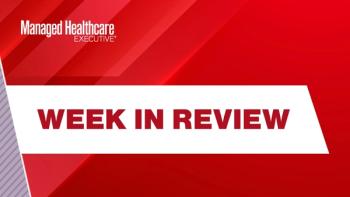
- Vol 28 No 7
- Volume 28
- Issue 7
Six Technologies That Will Transform Healthcare
These tools will reduce healthcare costs and improve care quality.
One day, patients will be able to walk into telephone booth-like structures that analyze changes to their moles. The information derived from the booth will then help dermatologists identify possible signs of melanoma. At least, that’s what Joseph Kvedar, MD, vice president of Partners Connected Health, which leverages information technology to deliver patient care outside traditional medical settings, hopes will happen in the near future.
“Computers do much better than humans do at detecting those changes,” says Kvedar, who is also a dermatologist at Boston’s Partners HealthCare.
To help support that point, he cites an article
In terms of the promise of artificial intelligence for clinical purposes, Kvedar casts the net much wider than dermatology. For example, specialties such as pulmonology, where lung changes need to be detected, and cardiology, where echocardiogram changes should be monitored, could benefit from the technology.
Here are five other technology developments to watch.
1. Digital health devices that help predict patient needs
One area that’s ripe for innovation is diabetes care, which costs $327 billion each year in the United States,
David Klonoff, MD, medical director at the Diabetes Research Institute at San Mateo, California’s Mills-Peninsula Medical Center, says that new wearable and implanted sensors that provide a “window into human physiology” are improving data collection among diabetic patients and patients with other chronic conditions.
“This torrent of data can be analyzed and stored in the cloud and then converted into actionable information, which can then be sent back to the patient,” he says.
Decision-support software can then instruct patients to take certain actions, such as taking more insulin, if no contraindications are present. For example, diabetes patients now have access to continuous glucose monitors which measure the glucose level every five minutes.
Klonoff adds that providers can use software to present patterns of glucose levels for future reference, advise what actions to take based on current levels and directional trends in glucose levels-and the software can also connect with insulin pumps to deliver appropriate doses of insulin.
What’s lacking, and what Klonoff hopes will be developed soon, is a process for assembling a highly detailed set of phenotypic and genotypic data that can predict outcomes and select the appropriate therapies for patients.
In addition, says Klonoff, healthcare leaders need to figure out how to validate the security of the vast amount of data generated by these and other medical devices, in addition to EHRs and other clinical and administrative applications (such as billing systems).
2. AI that helps payers and providers save time and money
As much buzz as there has been about using artificial intelligence for clinical purposes, companies that are using artificial intelligence for administrative services are increasingly receiving investment and attention.
Case in point: Mountain View, California-based Qventus, which recently received $30 billion in venture capital funding. The company launched with its first customer in 2014 and gives healthcare facilities real-time insight into their operations, such as the number of patients in the emergency room at any given time and opportunities to reduce unnecessary lab tests.
Harsha Madannavar, managing director and partner with L.E.K. Consulting, recommends keeping an eye on AI platforms that will help handle claims processing with a second level of scrutiny. That’s what payers really care about, he adds.
Futurists who want to figure out ways to optimize these processes for payers should focus on points of failure in the way claims are currently processed and opportunities to reduce the rate at which claims are reviewed inaccurately, says Madannavar.
3. Clinical support tools that improve decision making
One of the first specialties to adopt clinical support tools is radiology. Many radiologists interpreting digital mammography exams rely on computer-aided detection tools, which use algorithms to achieve high sensitivity and low false-positive rates to detect breast calcifications in mammograms.
In addition to improving diagnosis and treatment decisions, clinical support tools help radiologists interpret more exams each day. This will be helpful to the industry, especially given the aging population, Madannavar says.
One of the strongest value propositions for clinical support tools is their ability to reduce error rates, he says. For example,
Outside the world of radiology, clinicians are using decision support tools to improve outcomes for patients. At Stanford Children’s Hospital, a clinical support tool called Premie BiliRecs is helping pediatricians determine whether patients need to be treated for hyperbilirubinemia, a condition that occurs when there’s too much bilirubin. The result of the excess bilirubin is jaundice, which may appear at birth or at any time after birth.
Jonathan Palma, MD, a clinical associate professor in pediatrics/neonatal and development medicine at Stanford Children’s Hospital, helped develop this tool because the evidence consensus for lab values for jaundice is “a bit wishy washy,” he says. Without this tool, pediatricians must rely on relatively ill-defined parameters to assess the existence of excess bilirubin in their patients, he says.
Pediatricians-or other members of the care team in the pediatric intensive care unit-can enter the patient’s post-menstrual age and their total serum bilirubin into the tool to determine if phototherapy is appropriate. The tool is available online, and pediatricians at Stanford Children’s can launch the tool within the hospital’s EHR, which then captures the patient’s clinical information and populates the tool with that information.
While treatment of jaundice isn’t prohibitively expensive, Palma says payers should be interested in this tool because treatment can be resource intensive; that means a nurse has to uncover the baby, find the light, and put it on the baby. He also notes that the long-term side effects of phototherapy are unknown.
The tool was built in late 2015, made available for use in January 2016, and has been in use at Stanford Children’s since then. Premie BiliRecs has been accessed more than 44,000 times inside Stanford University and elsewhere, says Palma, who notes that, with the tool, adherence to clinical recommendations have gone up from 48% to 70% of median-and some months, it hits 90% adherence.
4. Technology that improves information sharing and care coordination
Blockchain technology is described by
While blockchain got its start in 2008, it wasn’t until 2014 or 2015 that the healthcare industry started to consider how it could solve some of its most pressing challenges, such as providing patients with access to their comprehensive health data, says Mike Jacobs, senior distinguished engineer at Optum.
Jacobs expects that the industry won’t truly embrace this technology for another two to five years, but he’s excited about Optum’s partnership with Humana, MultiPlan, and Quest Diagnostics on a pilot program that uses blockchain. This project will attempt to ensure that provider data is available in health plan provider directories. The current cost of researching and making available accurate provider data is $2.1 billion annually, according to an announcement about the partnership.
The goals of the pilot, which was announced in April, include providing consumers with accurate information when they need it and potentially reducing operating costs while improving data quality. Rather than each entity calling providers to update their information in provider directories, this information will be shared across the partner organizations using blockchain.
5. Decision-support tools for pre-authorization and prescription costs
Several payers are developing tools to help consumers and providers better understand the cost of prescriptions. UnitedHealthcare, for example, has developed a tool that doctors can use within their EHR to provide real-time drug prices to patients, says Tim Kaya, chief operating officer for UnitedHealthcare Networks. Called PreCheck MyScript, the tool is tied to the specific pharmacy where the patient picks up their prescriptions and can also process any necessary prior authorizations in real time.
The tool provides lower-cost drug alternatives and confirms the patient’s out-of-pocket cost based on their specific benefit plan, says Kaya, noting that between 20% to 30% of all new prescriptions result in a call back to the prescriber, typically because the patient wasn’t aware of their out-of-pocket cost or the prescription required a pre-authorization. With this tool there will be “no more surprises” when the patient walks into the pharmacy, says Kaya.
The tool has processed 2.3 million transactions since it launched in summer 2017.
Aine Cryts is a writer based in Boston.
Articles in this issue
over 7 years ago
Three Vaccine Developments Healthcare Execs Should Watchover 7 years ago
How Embedded Care Managers Reduce Readmissionsover 7 years ago
How New Initiatives Could Affect Generic Drug Costsover 7 years ago
Four Healthcare Executives Take On New Managed Care Rolesover 7 years ago
Top Four Causes of Female Mortality and Treatment AdvancesNewsletter
Get the latest industry news, event updates, and more from Managed healthcare Executive.

















































